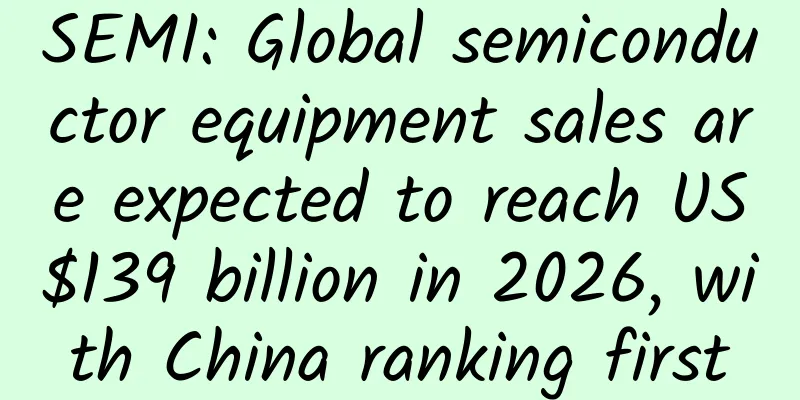SEMI: Global semiconductor equipment sales are expected to reach US$139 billion in 2026, with China ranking first

|
Recently, the Semiconductor Industry Association (SEMI), an industry association representing the global electronic product design and manufacturing supply chain, released a new report, predicting that global semiconductor equipment sales will reach US$113 billion in 2024, setting a new industry record, a year-on-year increase of 6.5%. Driven by the front-end and back-end markets, sales of semiconductor manufacturing equipment are expected to continue to increase in 2025 and 2026, further soaring to new records of US$121 billion and US$139 billion. Ajit Manocha, president and CEO of SEMI, said that the expected growth in semiconductor manufacturing investment for three consecutive years reflects the important role played by the semiconductor industry in supporting the global economy and promoting technological innovation. The outlook for semiconductor equipment sales in 2024 has become bright, especially with higher-than-expected investment in China and artificial intelligence (AI)-related industries. Combined with the forecast to 2026, it highlights the strong growth momentum of various market segments, applications and regions. After last year's record sales of $96 billion, the fab equipment segment, which includes wafer processing, wafer manufacturing facilities, and mask/slicing equipment, is expected to grow 5.4% to $101 billion in 2024, higher than SEMI's previous forecast of $98 billion. SEMI said that artificial intelligence computing has driven continued and strong equipment investment in DRAM and HBM. Looking ahead, sales of the fab equipment segment will continue to grow, with an increase of 6.8% in 2025 and 14% in 2026 to $123 billion. Equipment sales of the foundry and logic sectors are expected to remain flat at $58.6 billion as a share of total fab equipment revenue in 2024, and will resume growth in 2025, with an expected increase of 2.8%, and a 15% increase to $69.3 billion in 2026; DRAM equipment sales are expected to increase significantly, by 35.3% to $18.8 billion in 2024, and will increase by 10.4% and 6.2% in 2025 and 2026, respectively; NAND equipment sales are expected to be relatively weak in 2024, increasing by 0.7% to $9.3 billion, increasing by 47.8% to $13.7 billion in 2025, and increasing by 9.7% to $15.1 billion in 2026. If divided by region, China, Taiwan, and South Korea remain the top three regions for semiconductor equipment spending, with China expected to reach a record $49 billion in sales in 2024, consolidating its lead over other regions. Semiconductor equipment spending in most regions is expected to decline in 2024 and then rebound in 2025. After three years of massive investment, China is expected to contract in 2025. All tracked regions are expected to grow in 2026. From Super Energy Network |
<<: Will Apple TV's entry into the TV gaming field change the future of living room entertainment?
Recommend
The ninth portrait class of Ace will end in February 2022
Ace's Ninth Portrait Class, February 2022, Co...
How to make a Baidu Encyclopedia of characters? Which reference material is better?
How do I create a character entry in Baidu Encycl...
WeChat external link regulations have been updated: These behaviors are not allowed
WeChat recently announced that it will upgrade th...
Does eating baked sweet potatoes often cause cancer? Not really. The sweet potatoes that really shouldn't be eaten are →
Rumor: "Baked sweet potatoes are delicious, ...
How to convert the raw and cooked weights of food? The weights of food recommended by the New Dietary Pagoda are all raw weights.
On April 26, the long-awaited 2022 edition of the...
Can you let yourself go after the test turns negative? Experts urgently remind →
What does it mean to recover from COVID-19? Can y...
Android smartphone outlook for 2017: Full-screen smartphones explode, Huawei and Samsung compete for first place
According to foreign media reports, there are onl...
Zhao Yu's "User Experience Design Practical Notes"
When talking about a product, people often use use...
How to create explosive content? Share this 7-word mantra!
Beautiful, exciting, cute, warm, awesome, fun, an...
There is new news about my country’s manned lunar mission!
my country's manned lunar mission has fully e...
APICloud has been working hard for six years to build a low-code development platform with persistence and innovation
[51CTO.com original article] The rapid developmen...
There are bite marks on the shit. Who is so hungry?
If we want to peek into the mysteries left by anc...
How to trigger user growth? (The most complete mind map)
In fact, user growth is very common in our lives....
Exercise is good for your health, but you should also protect your knees
This is the 4421st article of Da Yi Xiao Hu Playi...
Why Israel will become the second Silicon Valley?
[[137896]] Whether in the East or the West, entre...





![[Scholars from the Saiwai] The Secret of Seeking the Dragon: Predicting the Leader at a Low Level + Prediction Before the Market Opens on 2022.5.9-5.13](/upload/images/67cc03a231df6.webp)



